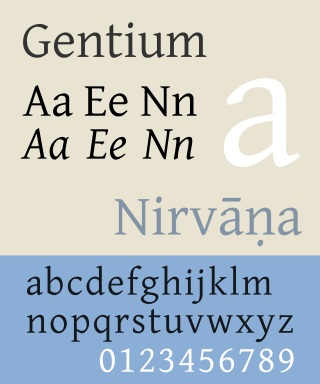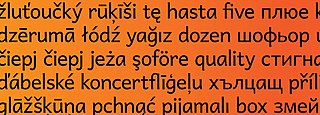
Nastaliq, also romanized as Nastaʿlīq or Nastaleeq, is one of the main calligraphic hands used to write the Perso-Arabic script and it is used for some Indo-Iranian languages, predominantly Classical Persian, Kashmiri, Punjabi (Shahmukhi) and Urdu. It is often used also for Ottoman Turkish poetry, but rarely for Arabic. Nastaliq developed in Iran from naskh beginning in the 13th century and remains widely used in Iran, Afghanistan, India, Pakistan, and other countries for written poetry and as a form of art.

Gentium is a Unicode serif typeface designed by Victor Gaultney. Gentium fonts are free and open source software, and are released under the SIL Open Font License (OFL), which permits modification and redistribution. Gentium has wide support for languages using the Latin, Greek, and Cyrillic alphabets, and the International Phonetic Alphabet (IPA). Gentium Plus variants released since November 2010 now include over 5,500 glyphs and advanced typographic features through OpenType and formerly Graphite.

Junicode ("Junius-Unicode") is a free and open-source old-style serif typeface developed by Peter S. Baker of the University of Virginia. The design is based on a 17th-century typeface used in Oxford, England.

There are Unicode typefaces which are open-source and designed to contain glyphs of all Unicode characters, or at least a broad selection of Unicode scripts. There are also numerous projects aimed at providing only a certain script, such as the Arabeyes Arabic font. The advantage of targeting only some scripts with a font was that certain Unicode characters should be rendered differently depending on which language they are used in, and that a font that only includes the characters a certain user needs will be much smaller in file size compared to one with many glyphs. Unicode fonts in modern formats such as OpenType can in theory cover multiple languages by including multiple glyphs per character, though very few actually cover more than one language's forms of the unified Han characters.

Naskh is a smaller, round script of Islamic calligraphy. Naskh is one of the first scripts of Islamic calligraphy to develop, commonly used in writing administrative documents and for transcribing books, including the Qur’an, because of its easy legibility.

The Urdu Wikipedia, started in January 2004, is the Standard Urdu-language edition of Wikipedia, a free, open-content encyclopedia. As of 27 June 2024, it has 207,378 articles, 181,275 registered users and 12,917 files, and it is the 54th largest edition of Wikipedia by article count, and ranks 20th in terms of depth among Wikipedias with over 150,000 articles. There were 6 million page views in January 2024.
The nuqta, is a diacritic mark that was introduced in Devanagari and some other Indic scripts to represent sounds not present in the original scripts. It takes the form of a dot placed below a character. This idea is inspired from the Arabic script; for example, there are some letters in Urdu that share the same basic shape but differ in the placement of dots(s) or nuqta(s) in the Perso-Arabic script: the letter ع ayn, with the addition of a nuqta on top, becomes the letter غ g͟hayn.

Charis SIL is a slab serif typeface developed by SIL International based on Bitstream Charter, one of the first fonts designed for laser printers. The font offers four family members: roman, bold, italic, and bold italic.

The Urdu alphabet is the right-to-left alphabet used for writing Urdu. It is a modification of the Persian alphabet, which itself is derived from the Arabic script. It has official status in the republics of Pakistan, India and South Africa. The Urdu alphabet has up to 39 or 40 distinct letters with no distinct letter cases and is typically written in the calligraphic Nastaʿlīq script, whereas Arabic is more commonly written in the Naskh style.
Many scripts in Unicode, such as Arabic, have special orthographic rules that require certain combinations of letterforms to be combined into special ligature forms. In English, the common ampersand (&) developed from a ligature in which the handwritten Latin letters e and t were combined. The rules governing ligature formation in Arabic can be quite complex, requiring special script-shaping technologies such as the Arabic Calligraphic Engine by Thomas Milo's DecoType.

Nastaliq Navees is a Nasta'liq-script font created by SIL's Jonathan Kew for the Macintosh platform. It requires Snow Leopard, or System 7.5-7.6 with QuickDraw GX installed to render correctly, and is the only functional Nasta'liq font on the Mac platform. On Leopard it will render slightly incorrectly, whilst on Tiger and earlier versions of Mac OS X it will cause a crash. Only the MacArabic-encoded font will work on Mac OS X as the MacRoman-encoded one does not correctly map to Unicode.

InPage is a word processor and page layout software by Concept Software Pvt. Ltd., an Indian information technology company. It is used for languages such as Urdu, Arabic, Balti, Balochi, Burushaski, Pashto, Persian, Punjabi, Sindhi and Shina under Windows and macOS. It was first developed in 1994 and is primarily used for creating pages in Urdu, using the Nasta`līq (نستعلیق) style of Arabic script.
In Urdu language, Awami is the adjectival form for Awam, the Urdu language word for common people.
Ahmad Mirza Jamil was a Pakistani calligrapher best known for creation of Noori style of Nastaliq, which was first created as a digital typeface in 1981.

Scheherazade New, formerly Scheherazade, is a traditional Naskh styled font for Arabic script created by SIL, freely available under the Open Font License. It supports a wide range of Arabic-based writing system encoded in Unicode. The font offers two family members: regular and bold.

Amar Nastaleeq is a Nastaliq style Embedded OpenType and TrueType Font which was lowest in size, created for web embedding on Urdu websites in 2013. The font was announced by Urdu poet Fahmida Riaz. Jang Group of Newspapers has rendered this font from the developers.
Lām with tah above is a character used in the Shahmukhi alphabet for the Punjabi language to represent a voiced retroflex lateral approximant and is also used in the Kalasha language.

Andika is a sans-serif typeface developed by SIL International for the Latin, Greek and Cyrillic scripts. It is designed for literacy programs and beginning readers, but also has support for IPA transcription and a large number of diacritics. The font offers four family members: roman, bold, italic and bold italic.













